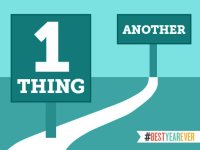Audience and Purpose
One thing leads to another.
A love for the power of words led me to write. A love for the craft of writing led me to write even when I wasn't told to or didn't have an assignment due. Which (somehow) led me to think that teaching writing might be a good idea. Which led me to having a look-see for myself at the classroom from the other side of the desk. Which led me to TeachThought and Edutopia.
And, by some impossibly chaotic but still entirely functional collection of digital possibility, you've turned on something electronic and ended up here, reading this.
Things connect.
Teaching English
And so it was for me as a teacher. Being an English teacher (that is, a teacher of literature, the writing process, grammar, critical thinking, close reading, decoding, digital media, speaking and listening, and -- well, you get the idea) was a very plaid experience, all divergent and striped and blocked and geometric, but still somehow stitched together.
Oddly, elegantly unified.
As curriculum and content, "English" is really a matter of understanding communication -- who said what, how they said it, and how you can use similar patterns to say things yourself. Diction, tone, grammar, theme, thesis statements, mood, structure, idea organization, supporting details, main idea, literary devices, and dozens of other things are all pieces in service of communication, both sending and receiving.
For some reason, once you get to college, communication is chunked into an idea of public speaking, but that's like teaching "shapes" independent of geometry. In order to speak, you have to know.
Traditionally in English, you take a close look at dead people that said noteworthy things, literature being "news that stays news." You take apart what they said, try to understand why they said it, and write a paper or take a test on it. Franz Kafka, William Faulkner, Flannery O'Connor, Emily Dickinson, and countless other "people that have lived but not anymore" were moved at one point to say something, wrote it down, and here we are centuries later, bubbling in Scantrons about it all. It's a bit weird.
But studying their poetry, speeches, novels, and other recorded and highly formatted musings led me to see it all as a matter of purpose and audience. Every time we study a piece of literature, or the concept of writing, it was the same pattern.
What was said, and to whom?
The Order Of Thinking
This came in handy when I started taking a look at digital media and other technology in service of studying the English-language arts curriculum. A YouTube video, like a poem, has the same fundamental characteristics, just different modalities -- word choice, structure, idea organization, tone, and the other bits that connote academic study. But both video and poem have an audience and a purpose. And without understanding the audience and purpose, none of the other stuff makes sense.
You can't evaluate the word choice of a poem until you have an idea about why it was written, and for whom (if anyone) -- in other words, context. You can speculate all day long about what he or she said and how he or she said it, but you're only speculating. You weren't there. You can analyze the meter or count the lines, but the poem itself is a conjuring born of audience and purpose -- which makes it a nearly human thing itself. Something was said to someone for some reason, and everything works backward from there.
It is this content of writing -- and reading, too -- that informs the bits and pieces we spend so much time taking apart. But audience and purpose are primal. They have to come first, or none of it makes any sense. This concept of audience and purpose goes much deeper. When students start on projects for project-based learning, have them start with audience and purpose. What are you doing, and why are you doing it? And for whom?
The same holds true with ed reform. How can we revise a school or iterate education before we know what a school is supposed to do or what an "education" is? That's purpose.
Most critically, we have to know who is the "audience" of education. We don't do this for curriculum or standards, for test makers or corporations, for universities or even for ourselves. If we say that it's the students, let's check that. Let's look at all of our systems, parts, and practices to see if they point to that audience.
Or we can start with our audience and work backward from there.
Understanding audience and purpose is critical for reading and writing. And project-based learning. And digital media. And ed reform. And pretty much everything else.
One thing leads to another.
